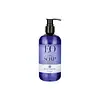What's inside
What's inside
 Key Ingredients
Key Ingredients

 Benefits
Benefits

 Concerns
Concerns

 Ingredients Side-by-side
Ingredients Side-by-side

Water
Skin ConditioningCocamidopropyl Hydroxysultaine
CleansingSodium Methyl Cocoyl Taurate
CleansingSodium Coco-Sulfate
CleansingCaprylyl/Capryl Glucoside
CleansingLavandula Angustifolia Oil
MaskingLavandula Hybrida Oil
EmollientAloe Barbadensis Leaf
MaskingChamomilla Recutita Flower Extract
MaskingCalendula Officinalis Flower Extract
MaskingCamellia Sinensis Leaf Extract
AntimicrobialCitric Acid
BufferingSodium Phytate
Potassium Sorbate
PreservativeSodium Levulinate
Skin ConditioningWater, Cocamidopropyl Hydroxysultaine, Sodium Methyl Cocoyl Taurate, Sodium Coco-Sulfate, Caprylyl/Capryl Glucoside, Lavandula Angustifolia Oil, Lavandula Hybrida Oil, Aloe Barbadensis Leaf, Chamomilla Recutita Flower Extract, Calendula Officinalis Flower Extract, Camellia Sinensis Leaf Extract, Citric Acid, Sodium Phytate, Potassium Sorbate, Sodium Levulinate
Water
Skin ConditioningCocamidopropyl Hydroxysultaine
CleansingSodium Coco-Sulfate
CleansingCaprylyl/Capryl Glucoside
CleansingSodium Chloride
MaskingCoco-Glucoside
CleansingPanthenol
Skin ConditioningEucalyptus Dives Leaf Oil
PerfumingEucalyptus Globulus Leaf Oil
PerfumingCitrus Medica Peel Oil
Lavandula Angustifolia Oil
MaskingSalvia Sclarea Oil
MaskingCedrus Deodara Wood Oil
MaskingPicea Mariana Leaf Oil
MaskingPicea Glauca Branch/Leaf Oil
MaskingThymus Vulgaris Flower/Leaf Oil
MaskingAloe Barbadensis Leaf Juice
Skin ConditioningChamomilla Recutita Flower Extract
MaskingCalamintha Officinalis Flower/Leaf/Stem Extract
Skin ConditioningGlycerin
HumectantCitric Acid
BufferingSodium Phytate
Phenoxyethanol
PreservativeBenzyl Alcohol
PerfumingPotassium Sorbate
PreservativeTocopherol
AntioxidantLimonene
PerfumingWater, Cocamidopropyl Hydroxysultaine, Sodium Coco-Sulfate, Caprylyl/Capryl Glucoside, Sodium Chloride, Coco-Glucoside, Panthenol, Eucalyptus Dives Leaf Oil, Eucalyptus Globulus Leaf Oil, Citrus Medica Peel Oil, Lavandula Angustifolia Oil, Salvia Sclarea Oil, Cedrus Deodara Wood Oil, Picea Mariana Leaf Oil, Picea Glauca Branch/Leaf Oil, Thymus Vulgaris Flower/Leaf Oil, Aloe Barbadensis Leaf Juice, Chamomilla Recutita Flower Extract, Calamintha Officinalis Flower/Leaf/Stem Extract, Glycerin, Citric Acid, Sodium Phytate, Phenoxyethanol, Benzyl Alcohol, Potassium Sorbate, Tocopherol, Limonene
Ingredients Explained
These ingredients are found in both products.
Ingredients higher up in an ingredient list are typically present in a larger amount.
Caprylyl/Capryl Glucoside is an alkyl glucoside. This just means it is creating by reacting alcohol and sugar. It is a cleansing and foaming ingredient.
Caprylyl/Capryl Glucoside helps remove the dirt, oil, and other pollutants from your skin.
Chamomilla Recutita Flower Extract comes from the Chamomile flower.
Chamomile is rich in antioxidants and has anti-inflammatory properties. Several compounds found in chamomile help with soothing, such as bisbolol.
Antioxidant components in chamomile make it an effective ingredient to help slow the signs of aging. Antioxidants help fight free-radical molecules, or molecules that may damage your skin.
Essential oils from chamomile have been found to improve wound healing due to its antimicrobial properties.
Ancient Greeks and Egyptians used Chamomile to treat skin redness and dryness. Chamomile has also been used to help treat stomach issues.
Learn more about Chamomilla Recutita Flower ExtractCitric Acid is an alpha hydroxy acid (AHA) naturally found in citrus fruits like oranges, lemons, and limes.
Like other AHAs, citric acid can exfoliate skin by breaking down the bonds that hold dead skin cells together. This helps reveal smoother and brighter skin underneath.
However, this exfoliating effect only happens at high concentrations (20%) which can be hard to find in cosmetic products.
Due to this, citric acid is usually included in small amounts as a pH adjuster. This helps keep products slightly more acidic and compatible with skin's natural pH.
In skincare formulas, citric acid can:
While it can provide some skin benefits, research shows lactic acid and glycolic acid are generally more effective and less irritating exfoliants.
Most citric acid used in skincare today is made by fermenting sugars (usually from molasses). This synthetic version is identical to the natural citrus form but easier to stabilize and use in formulations.
Read more about some other popular AHA's here:
Learn more about Citric AcidCocamidopropyl Hydroxysultaine is a synthetic cleansing agent, though it is derived from coconut oil.
It is used to enhance the texture of products by boosting lather and thickening the texture. As a cleanser, Cocamidopropyl Hydroxysultaine is mild.
Lavandula Angustifolia Oil is more commonly known as lavender essential oil. It is considered a fragrancing ingredient.
Lavender imparts a famous scent. While the smell is lovely, this ingredient and may sensitize skin in topical products. This is because about 85% of the oil is made up of linalool and linalyl acetate.
When exposed to air, these two compounds become strong allergens. This ingredient exhibits cytotoxicity at low concentrations; amounts of 0.25% have been shown to damage skin cells.
A study from Japan found this ingredient caused lavender sensitivity after widespread exposure.
Lavender essential oil has some antimicrobial, antibacterial, and anti-inflammatory properties. However, the cons of this ingredient may outweight the pros.
More research is needed to confirm lavender essential oil's effects when used in aromatherapy.
Lavandula Angustifolia is known as the English Lavender and famous for creating purple fields in Provence, France.
Learn more about Lavandula Angustifolia OilPotassium Sorbate is a preservative used to prevent yeast and mold in products. It is commonly found in both cosmetic and food products.
This ingredient comes from potassium salt derived from sorbic acid. Sorbic acid is a natural antibiotic and effective against fungus.
Both potassium sorbate and sorbic acid can be found in baked goods, cheeses, dried meats, dried fruit, ice cream, pickles, wine, yogurt, and more.
You'll often find this ingredient used with other preservatives.
Learn more about Potassium SorbateSodium Coco-Sulfate is a type of sulfate.
Sodium Phytate is the synthetic salt form of phytic acid. Phytic acid is an antioxidant and can be found in plant seeds.
Sodium Phytate is a chelating agent. Chelating agents help prevent metals from binding to water. This helps stabilize the ingredients and the product.
Water. It's the most common cosmetic ingredient of all. You'll usually see it at the top of ingredient lists, meaning that it makes up the largest part of the product.
So why is it so popular? Water most often acts as a solvent - this means that it helps dissolve other ingredients into the formulation.
You'll also recognize water as that liquid we all need to stay alive. If you see this, drink a glass of water. Stay hydrated!
Learn more about Water